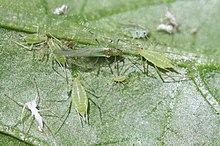Macrosiphum euphorbiae
| Macrosiphum euphorbiae | |
|---|---|
 |
|
| Winged and wingless potato aphids and cast skins. | |
| Scientific classification | |
| Kingdom: | Animalia |
| Phylum: | Arthropoda |
| Class: | Insecta |
| Order: | Hemiptera |
| Family: | Aphididae |
| Genus: | Macrosiphum |
| Species: | M. euphorbiae |
| Binomial name | |
|
Macrosiphum euphorbiae Thomas, 1878 |
|
| Synonyms | |
|
|
Macrosiphum euphorbiae, the potato aphid, is a sap-sucking pest insect in the family Aphididae. It infests potatoes and a number of other commercially important crops.
Macrosiphum euphorbiae originated in North America but it has spread to the temperate parts of Europe and Asia and is found in all areas in which potatoes are grown.
The wingless female potato aphid is green or occasionally pink, often with a darker dorsal stripe. It has a pear-shaped body reaching about four millimetres long. The antennae are dark at the joints between the segments and are longer than the body. They are set on outward facing tubercles. The legs are longer than in other aphids, pale green but darker at the apices. The siphunculi are pale coloured, cylindrical with dark tips and operculi, and are about one third the length of the body. The tail is sword-shaped and bears 6 to 12 hairs and is much shorter than the siphunculi. The winged female has a uniform darker coloured body and appendages and has a green abdomen. The nymphs are like miniature versions of the adults and go through several moults in the course of about ten days.
The green biotype is most often found on the lower, older leaves of potato plants whereas the pink biotype had no such preference. The numerical predominance of the green biotype was greater on older plants.
Female potato aphids overwinter as eggs on weeds, the sprouts of potatoes in storage and on lettuce under glass. They usually emerge in April and begin feeding on perennial weeds, preferring plants in the family Chenopodiaceae. In May or early June, they migrate to potato, cabbage, tomato and others crops where they feed on shoots, the lower side of leaves, buds and flowers, often on the lower parts of the plant. They are highly polyphagous, feeding on over two hundred species in more than twenty plant families, but their preference is for plants in the family Solanaceae. The female produces up to seventy young by parthenogenesis over the course of three to six weeks and there may be ten generations over the summer. The optimum temperature for population increase is 68 °F. When populations build up, winged individuals are produced and fly off to infest new host plants. The production of winged individuals is also dependent on the day length, the temperature, the parent type (winged or wingless) and the generation.
...
Wikipedia
